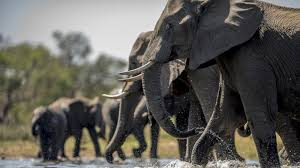Ministry criticises Wildlife Institute’s report on captive elephants for ‘copy-paste’, using African tusker instead of Asian on cover

Wildlife Institute Elephant Report Criticism Sparks National Outrage
New Delhi, July 7, 2025: The Wildlife Institute elephant report criticism has triggered strong reactions across India’s conservation community. The Ministry of Environment, Forest and Climate Change (MoEFCC) flagged two major issues—plagiarism and an incorrect elephant image on the cover.
The report, focused on the welfare of captive elephants in India, has faced backlash for poor research quality and an embarrassing visual mistake.
Cover Image Confuses Species
The report features an African elephant on its cover, even though India is home to the Asian elephant. Experts quickly noticed the mistake and voiced concern.
“African elephants have large ears and a different body shape,” said a senior MoEFCC official. “How could such a basic error pass unnoticed?”
This misstep raised questions about the credibility of the document. Conservationists argue that if the image is wrong, the content could also be flawed.
Report Content Lacks Originality
The ministry also accused the Wildlife Institute of reusing material from older publications. Many sections appear to match content from previous reports and international guidelines.
“There’s barely any original research,” said a review committee member. “We found multiple paragraphs repeated from earlier documents without proper citation.”
This practice undermines the scientific integrity of the report and calls the institute’s editorial standards into question.
Ministry Orders Immediate Correction
After reviewing the report, the ministry demanded a revision. Officials sent a formal notice to WII asking for a complete explanation. They also asked for updated visuals and verified data.
Sources within the ministry say the report will undergo a fresh review. Officials plan to form an expert panel for future quality checks.
Read the Wildlife Protection Act for more context on India’s laws on captive wildlife.
Experts Demand Higher Standards
Many experts believe this incident shows deeper flaws in India’s conservation research system. Dr. N. Ramachandran, a retired forest officer, said, “This report was an opportunity to improve elephant welfare. Instead, it turned into a case study in carelessness.”
India has over 2,500 captive elephants. Most of them live in temples, zoos, or private facilities. Many face poor conditions due to a lack of regulation and funding. A credible, data-driven report could have guided better policies.
Instead, experts say the Wildlife Institute missed the chance to make a real difference.
Internal & External Resources
- Wildlife Institute of India Reports
- India’s Captive Elephant Challenges
- Difference Between African and Asian Elephants
Reform is the Only Way Forward
This controversy has sparked important conversations. It’s not just about a wrong image or some copied paragraphs—it’s about trust. If official reports contain errors, how can the public and policymakers rely on them?
Conservation needs more than just data—it needs accuracy, responsibility, and field-based research.
The Wildlife Institute elephant report criticism may lead to better checks and reforms. But only time will tell if lessons are learned or forgotten.






